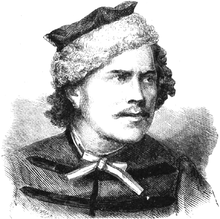| Revision as of 21:43, 23 November 2021 edit+JMJ+ (talk | contribs)Extended confirmed users20,658 editsmNo edit summaryTags: Reverted Visual edit← Previous edit | Revision as of 21:50, 23 November 2021 edit undoGizzyCatBella (talk | contribs)Extended confirmed users, Pending changes reviewers, Rollbackers17,604 edits Confusing - it was an insurrection in Russia's Kingdom of Poland aimed at the restoration of the Polish–Lithuanian Commonwealth plus "important" no doubt he was important but this needs to be sourced.Tags: Reverted Visual editNext edit → | ||
| Line 9: | Line 9: | ||
| }} | }} | ||
| '''Boleslovas Kajetonas Kolyška''' ({{Lang-pl|Bolesław Kajetan Kołyszko}}; 1838{{Sfn|Čepėnas|1957|p=223}} – 9 June ] 28 May]{{Sfn|Čepėnas|1957|p=223}} 1863) was |
'''Boleslovas Kajetonas Kolyška''' ({{Lang-pl|Bolesław Kajetan Kołyszko}}; 1838{{Sfn|Čepėnas|1957|p=223}} – 9 June ] 28 May]{{Sfn|Čepėnas|1957|p=223}} 1863) was a participant of the ]. | ||
| == Early life == | == Early life == | ||
Revision as of 21:50, 23 November 2021
| Boleslovas Kajetonas Kolyška | |
|---|---|
 | |
| Nickname(s) | Rutkowski, Szyszka |
| Born | 7 August 1837 Navickiškės [lt] |
| Died | 9 June 1863 Vilnius |
Boleslovas Kajetonas Kolyška (Template:Lang-pl; 1838 – 9 June 1863) was a participant of the January Uprising.
Early life

Kolyška was born into a petty noble family as a son of Wincenty Kołyszko and his wife from the Jursza family. He had an older brother, Feliksas Kolyška, who also fought in the January Uprising. Boleslovas Kolyška graduated from the Vilnius Gymnasium and studied law in the University of Moscow. According to Fajnhauz, he might have graduated from Lida gymnasium instead of Vilnius. In the University of Moscow, Kolyška was part of the Polish students association called "Ogół". He was arrested in 1861 for his involvement in student demonstrations in Lida. At the end of 1861, after a short imprisonment, he emigrated to Italy, where he met Ludwik Mierosławski. First in Genoa and later in Cuneo, he studied in the Polish Military School [pl].
Uprising of 1863
After the start of the uprising he went back to Lithuania. On 21 March 1863, he began the uprising between Čekiškė and Panevėžys. In a few days, his unit included 400 men and was also joined by the unit led by the priest Antanas Navaina. As he organized the rebel group near Kaunas during March, it was joined by the groups of Bronislavas Žarskis and Antanas Norvaiša. The combined group was called the Dubysa Regiment. Kolyška led his 400 men strong regiment in fights against units of the Imperial Russian Army at Aukštdvaris on March 29-30. He then fought near Lenčiai on April 1 (together with the unit of Tomas Kušleika), near Misiūnai [lt] on April 11.
By Zygmunt Sierakowski's order, he led a rebel column - two battalions and a cavalry unit that fought in the battle of Biržai. Kolyška and Sierakowski's aide-de-camp Jarosław Kossakowski [pl] were supposed to take wounded Sierakowski and transport him out of the country, but they were captured on May 10. During the interogation he blamed Sierakowski for the uprising's failure and underlined that he was doing everything for the homeland. He was hanged by a court-martial on June 9, 1863.
The remains were secretly buried in Vilnius' Gediminas' Hill. They were found in 2017 during the works designed to strengthen Gediminas' Mountain [lt]. On 22 November 2019, the remains were solemnly buried in the Columbarium of the Rasos Cemetery Chapel [lt] in Vilnius.
Sources
- ^ Čepėnas 1957, p. 223.
- ^ Fajnhauz 1968, p. 368.
- ^ Fajnhauz 1968, p. 369.
- ^ "Kolyška Boleslovas Kajetonas". Istorikas.lt (in Lithuanian). 2013-09-30.
{{cite web}}: CS1 maint: url-status (link) - Maksimaitienė, Ona (2006). Boleslovas Kajetonas Koliška (in Lithuanian). Vol. X (Khmerai-Krelle). Vilnius: Mokslo ir enciklopedijų leidybos institutas. p. 372.
{{cite book}}:|work=ignored (help) - Bairašauskaitė, Tamara (2019). 1863 -1864 m. sukilėlių kelias į mirtį ir atgimimą (in Lithuanian). Vilnius: National Museum of Lithuania. ISBN 978-609-478-031-8.
- "1863–1864 m. sukilimo vadų ir dalyvių valstybinių laidotuvių ceremonija vyks 2019 m. lapkričio 22 d." kam.lt (in Lithuanian). 22 October 2019.
{{cite web}}: CS1 maint: url-status (link)
Bibliography
- Čepėnas, Pranas (1957). "Boleslovas Kolyška". Lietuvių enciklopedija (in Lithuanian). Vol. 12. Boston. p. 223.
{{cite encyclopedia}}: CS1 maint: location missing publisher (link) - Fajnhauz, Dawid (1968). "Bolesław Kołyszko". Polski Słownik Biograficzny (in Polish). Vol. 13. Wrocław. pp. 84–85.
{{cite encyclopedia}}: CS1 maint: location missing publisher (link)